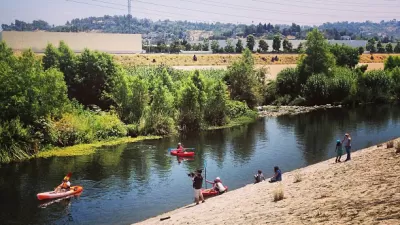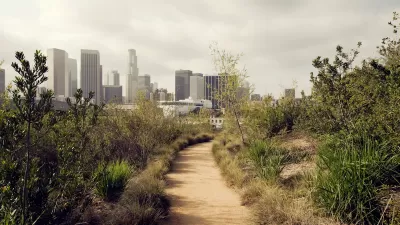When the U.S. Army Corps of Engineers announced its preference for a $1.08 billion plan to restore habitat in the Los Angeles River, many credited Lewis MacAdams's fight to change the city's relationship with its waterway over nearly three decades.

Despite its history as the ecological feature around which original Angelenos formed their settlement, the Los Angeles River has long been a concrete-encased flood control channel. That is now changing. On May 28, the Army Corps of Engineers announced that it would recommend Alternative 20 as its preferred approach for revitalizing the Los Angeles River. The decision, which marked a significant change from the Corps’ original plan to support the half-as-ambitious Alternative 13, was cause for Lewis MacAdams to celebrate. His non-profit, Friends of the Los Angeles River, began calling for river revitalization starting in 1986.
In an exclusive conversation with The Planning Report, MacAdams gives an overview of Alternative 20 and provides insight into the long process that brought about the Army Corps’ announcement--focusing on changing relationships between local, state, and federal players. In light of California's state-wide drought, he notes the relationship between water recycling and flow in the river. MacAdams also identifies the recreational activities already taking place there, and the opportunities soon possible due to the recent decision.
In his words, "The thrilling part of it for me, personally, is that Alternative 20 begins to fulfill some of my own goals from when I started Friends of the Los Angeles River. We will start to see habitat restored. When people ask me, 'How will you know when your work is done?' I always say, 'When the steelhead trout run returns to the Los Angeles River.' This won’t directly make that happen, but it’s a big step toward it."
FULL STORY: Lewis MacAdams on Army Corps’ LA River Revitalization Alternative 20

Planetizen Federal Action Tracker
A weekly monitor of how Trump’s orders and actions are impacting planners and planning in America.

Maui's Vacation Rental Debate Turns Ugly
Verbal attacks, misinformation campaigns and fistfights plague a high-stakes debate to convert thousands of vacation rentals into long-term housing.

San Francisco Suspends Traffic Calming Amidst Record Deaths
Citing “a challenging fiscal landscape,” the city will cease the program on the heels of 42 traffic deaths, including 24 pedestrians.

Defunct Pittsburgh Power Plant to Become Residential Tower
A decommissioned steam heat plant will be redeveloped into almost 100 affordable housing units.

Trump Prompts Restructuring of Transportation Research Board in “Unprecedented Overreach”
The TRB has eliminated more than half of its committees including those focused on climate, equity, and cities.

Amtrak Rolls Out New Orleans to Alabama “Mardi Gras” Train
The new service will operate morning and evening departures between Mobile and New Orleans.
Urban Design for Planners 1: Software Tools
This six-course series explores essential urban design concepts using open source software and equips planners with the tools they need to participate fully in the urban design process.
Planning for Universal Design
Learn the tools for implementing Universal Design in planning regulations.
Heyer Gruel & Associates PA
JM Goldson LLC
Custer County Colorado
City of Camden Redevelopment Agency
City of Astoria
Transportation Research & Education Center (TREC) at Portland State University
Jefferson Parish Government
Camden Redevelopment Agency
City of Claremont





























